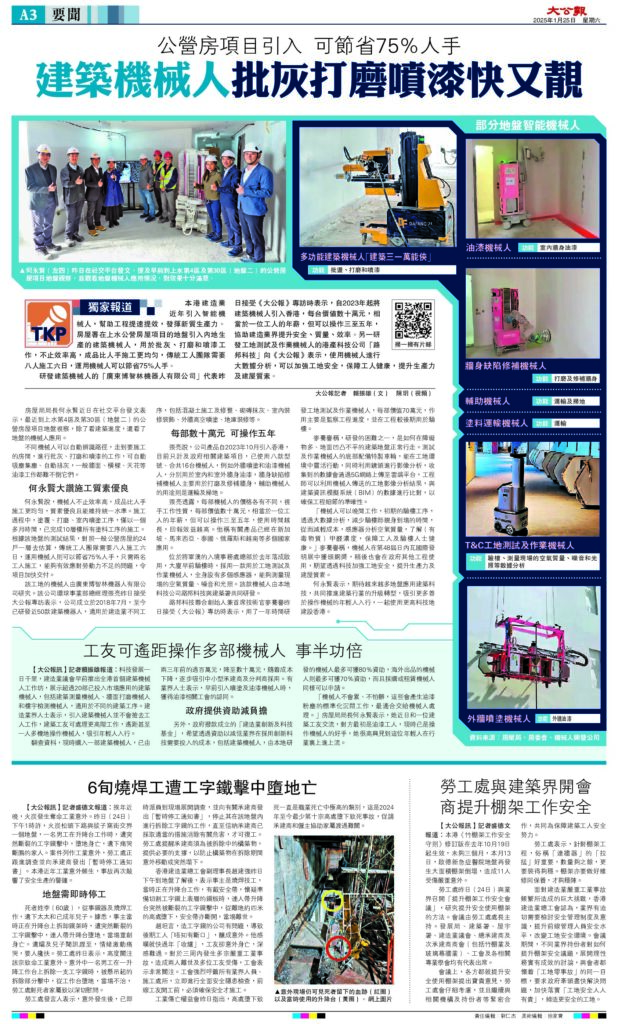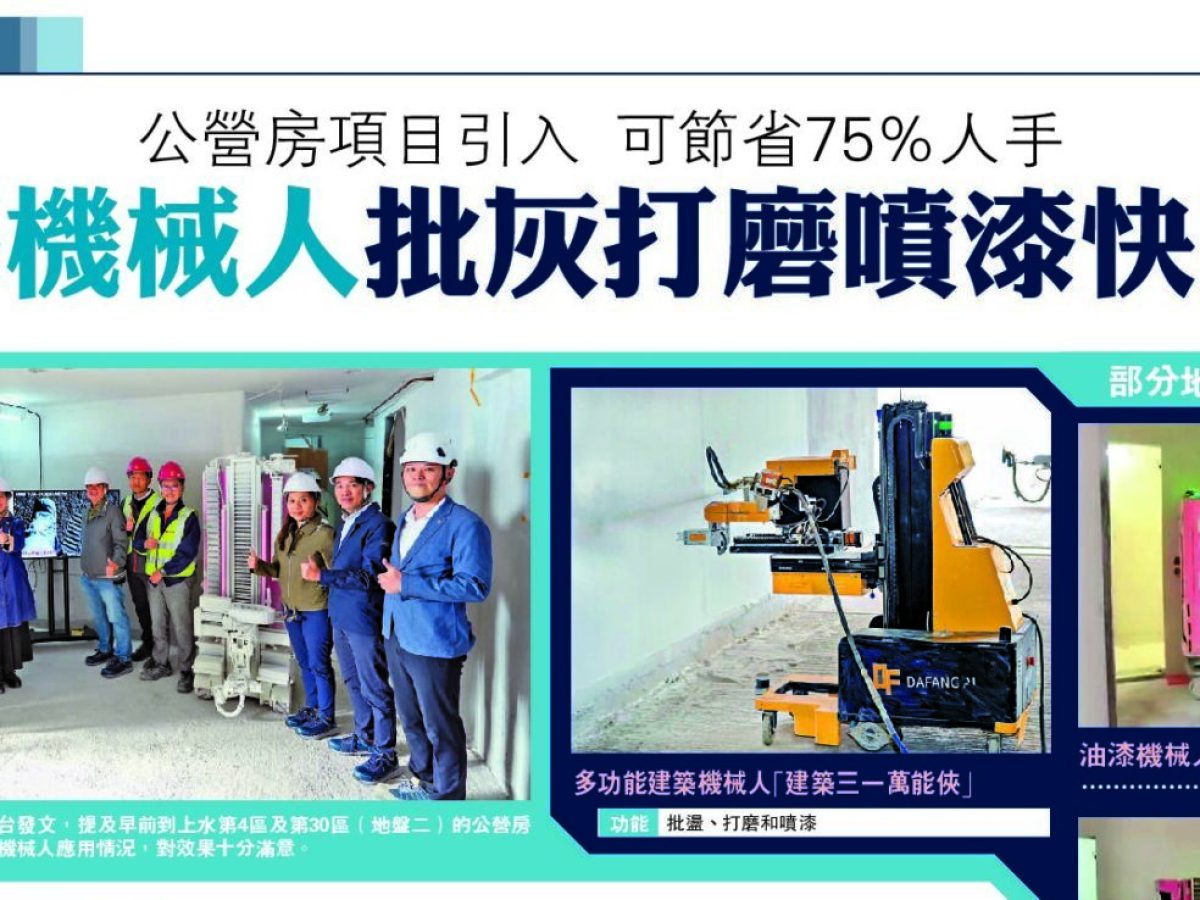In recent years, Hong Kong’s construction industry has introduced intelligent robots to help speed up projects and enhance productivity, unleashing new qualitative production capabilities. The Housing Department has introduced mainland-produced construction robots onto public housing project sites in Sheung Shui for plastering, sanding, and painting tasks. Not only are they efficient, but the finished products are also more uniform than those produced by manual labor. A traditional worker team requires eight people for six days of work, while using robots can save 75% of the manpower, requiring only two workers.
A representative from “Guangdong Bozhilin Robotics Co., Ltd.”, which develops construction robots, said in an exclusive interview with Ta Kung Pao yesterday that construction robots have been introduced to Hong Kong since 2023. Each robot costs several hundred thousand Hong Kong dollars, equivalent to the annual salary of a worker, but it can operate for three to five years, assisting the construction industry to improve safety, quality, and efficiency. Another locally produced technology company, “RoadBond Technology”, which develops site testing and operational robots, told Ta Kung Pao that using robots for big data analysis can enhance site safety, safeguard worker health, and improve productivity and housing quality.
Recently, Winnie Ho Wing-yin, Secretary for Housing, posted on social media that she visited the public housing project sites in Areas 4 and 30 (Site 2) in Sheung Shui, where she observed not only the construction progress but also the application of robots on the site.
Different robots can automatically recognize paths and navigate to the rooms where work needs to be done, performing plastering, sanding, and painting tasks. They can automatically collect dust and discharge it. Standard painting tasks such as walls, beams, and ceilings are no challenge for them.
Winnie Ho Wing-yin Praises Excellent Construction Quality
Winnie Ho Wing-yin said that robots are not only efficient but also produce more uniform finished products with excellent quality and consistent standards. During the construction process, tasks such as coating, sanding, and indoor spraying were completed for all paint processes on 10 floors in just over a month. Based on test results from the site, compared to the estimate of about 24 units per floor for general public housing, a traditional worker team requires eight people for six days of work, while using robots can save 75% of the manpower, requiring only two workers. This can effectively address the issue of labor shortage and accelerate project delivery.
The robots on this site were developed by Guangdong Bozhilin Robotics Co., Ltd. Zhang Liang, General Manager of the company’s Global Business Department, said in an exclusive interview with Ta Kung Pao yesterday that the company was established in July 2018 and has developed nearly 50 types of construction robots suitable for different construction processes, including concrete construction and finishing, bricklaying and plastering, interior decoration, exterior wall high-altitude spraying, and basement renovation.
Each Costs Several Hundred Thousand Hong Kong Dollars and Can Operate for Five Years
Zhang Liang said that the company’s products were introduced to Hong Kong in October 2023. Currently, considering only government-related construction projects, eight models and a total of 16 robots have been used, such as exterior wall spraying and painting robots for indoor and outdoor wall painting, wall defect repair robots mainly used for sanding and repairing walls, and auxiliary robots for transportation and sweeping.
Zhang Liang revealed that the price of each robot varies depending on its function, ranging from several hundred thousand Hong Kong dollars, equivalent to the annual salary of a worker, but it can operate for three to five years. The longer it is used, the higher the return on investment. He said that the relevant products have already been used in multiple countries such as Singapore, Malaysia, Thailand, Russia, and Vietnam.
The Immigration Department Headquarters in Tseung Kwan O was completed and opened last year. During an earlier building inspection, a robot used for site testing and operations, equipped with multiple sensors all over its body, was able to measure air quality, noise, and lighting on-site. This robot was jointly developed by local technology company RoadBond Technology and the Buildings Department.
Mark Mak, Co-founder and Chief Technology Officer of Roborn Technology, said in an exclusive interview with Ta Kung Pao yesterday that it took a year to develop the site testing and operational robot, which costs 700,000 Hong Kong dollars each. Its main function is to monitor project progress and be used for building inspections later in the project.
Mak said that one of the challenges in development was how to enable the robot to navigate normally on construction sites with many obstacles and uneven ground. The bottom of the testing and operational robot is equipped with specially made wheels, allowing it to move flexibly in construction site environments. At the same time, it uses cameras for image analysis, and the collected data is uploaded to a cloud platform via a 5G network. Engineers can use the analysis results of the site images transmitted by the robot to compare them with data from the Building Information Modeling (BIM) system to ensure the accuracy of engineering details.
“The robot can work at night. In the initial stages of building inspections, big data analysis can reduce the time that inspection engineers need to be physically present, thereby reducing costs. Sensors analyze air quality and measure formaldehyde concentrations to safeguard the health of workers and inspection personnel,” Mak said. The robot won a bronze award at the 48th International Exhibition of Inventions of Geneva and will be used in other government projects later. RoadBond Technology hopes to enhance site safety, improve productivity, and enhance housing quality through technology.
Winnie Ho Wing-yin said she looks forward to more sites applying construction technology to jointly promote the upgrading and transformation of the construction industry, attracting more young people skilled in operating machines to join the industry and work together to build Hong Kong with higher technology.
Workers Can Operate Multiple Robots Remotely for Greater Efficiency
Technology is advancing rapidly. The Construction Industry Council recently launched Hong Kong’s first construction robot workshop, showcasing over 20 construction robots already on the market, including building measurement robots, wall sanding robots, and building inspection robots, suitable for different construction processes. Industry insiders said that the introduction of construction robots does not take away jobs from workers. Construction workers can handle higher-level tasks and even operate multiple robots remotely, attracting young people to join the industry.
According to research, the current cost of purchasing a construction robot has dropped from over a million Hong Kong dollars two or three years ago to several hundred thousand Hong Kong dollars. As costs decrease, they are gradually attracting small and medium-sized contractors and subcontractors to adopt them. Some industry insiders said that when painting and spraying robots were introduced earlier, they received approval from paint-related unions.
Government Subsidies to Reduce Burden
In addition, the “Construction Industry Innovation and Technology Fund” established by government funding aims to reduce the cost for the industry to adopt innovative technologies, including construction robots. Locally developed robots can receive a subsidy of up to 80%, while overseas-produced robots can receive a subsidy of up to 70%. Applications can also be made for the procurement or leasing of robots.
“Robots don’t get tired or dirty. These standardized and monotonous tasks that generate paint dust are best handled by robots,” Winnie Ho Wing-yin said. She recently spoke with a construction worker who was initially a painter but is now skilled in operating robots. She was pleased to see this young person progressing in the industry.


